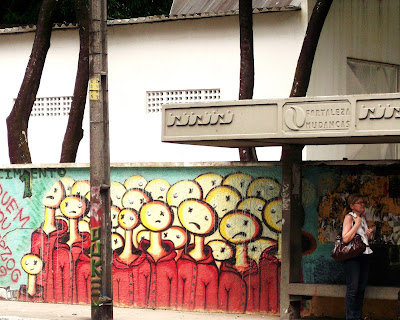At the bus stop, on the way to the IFCE for a Portuguese lesson, the Circular #2 drove on by. Any bus stop in Fortaleza may have several routes on it, and in order to get the bus to stop, just stand on the curb and stick out your arm. Anything else would just slow down traffic and the service.
 |
| Fortaleza Mudancas |
Luckily, a moto-taxi was waiting on the side walk near-by. When communication quickly became confusing for us, I was lucky to have connected with Vitor, my Portuguese professor from the IFCE. From the Moto-taxi drivers cell phone we called Vitor for translation and we were on our way. This was my first ride as a passenger in about ten years and at first it was a white knuckle ride. Once I relaxed I really began to enjoy the ride. Walking and Tour Buses have their merits, but I believe that a Motorcycle is the best way to explore a city. Those of you who ride will know this to be true; that the feeling of the wind in your face, and the cement beneath your feet can be a much richer, connected experience than the comparatively separated experience of the view through the TV like, air conditioned windshield.
 |
| Girád the Moto-taxi driver |
The very skilled moto-taxi driver took us through lots of new territory at speed. Once we stopped at an intersection and a pretty lady on a small black Honda drove up, she and the Mototaxi driver began to talk and continued to talk at around 60 KM/h along the side streets of Fortaleza.
 |
| Beira Mar |
Globally, locally, internationally, or next door, I’ve found that a consistent key to network and relationship building has been connecting about something you both love and are passionate about. Whether it’s socially or professionally this is a main factor when connecting with local people and partners. One thing that I love is motorcycles.
In the eternal summer of North East Brazil, motorcycles are an economical, practical and fast way to get around the city. It’s faster than any other type off vehicle because the rules of the road differ greatly from Canada’s comparatively orderly roads, where I’ve been driving a small CC motorcycles for 10+ years.
Light Bikes, built with dirt bike like suspensions are favoured by most riders; however I’ve also spotted the rare 1200+ CC guzzler roaring by. From what I’ve observed some of the motorcycles driving conventions include:
1. Using the horn to notify other drivers of your location. It’s expected, use it frequently.
2. When coming to a red light with no oncoming traffic, pass as many stopped cars as possible before re-entering the lane to avoid oncoming traffic.
3. Lane-splitting is acceptable, similar to California, and driving between cars stopped at an intersection to get to the front of the line of cars is the norm. It may also be the safest option in order to avoid being rear-ended, it places the motorcyclists ahead of traffic and it’s common to see half a dozen motorcycles racing ahead of a group of cars where they are most visible in traffic. When exiting and re-entering traffic stopped at an intersection riders signal to the left. Conventions regarding signaling lane and lane position changes are less clear, not unlike many North America drivers.
4. Lane position when riding on open streets is similar to North America. The rider in the left lane rides on the right side of the lane near the lane divider and the driver in the right lane on the left side of the lane. These two positions normally ensure greater blind spot visibility and a smoother ride. One difference is that some riders will drive side by side and converse, which has been an interesting difference in the way local people connect.
Good Day!
Bon Dia!
Bon Dia!
Please take me to ...
Por favour meleve para...
Por favour meleve para...
What is the cost?
Qual é o custo?
Qual é o custo?
Thank you.
Obrigado/a.
Obrigado/a.
 |
| Grant Dalton |


